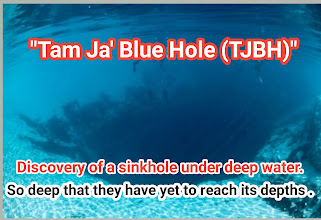Discovery of a sinkhole under deep water. So deep that they have yet to reach its depths . "Tam Ja' Blue Hole (TJBH)".
Researchers have discovered a sinkhole beneath the deep waters. So deep that they have yet to reach the bottom of it.
Knowledge story : The Tam Ja' Blue Hole (TJBH), located off the southeastern coast of the Yucatan Peninsula in Mexico, is the world's deepest sinkhole. It extends to at least 420 meters (1380 feet) below the ocean surface. Sinkholes are essentially deep pits or cavities formed within the sea where whirlpools are generated. It is 146 meters (480 feet) deep, experts first documented it when they discovered the Blue Hole in 2021.
It surpasses the previous record-holder, the Dragon Hole (also known as the Sansha Yongle Blue Hole), in the South China Sea by 118 meters (390 feet).
A scuba diving expedition was conducted on December 6, 2023, to identify the environmental conditions present at TJBH," researchers wrote in a study published Monday (April 29) in the Frontiers in Marine Science journal. During the mission, the team used a special probe to measure the depth, temperature, and salinity of the water, which can indicate the characteristics of the ocean and help them send real-time data to the surface.
It has been stated that the Tam Ja' Blue Hole is the "world's deepest unfathomable Blue Hole." Researchers have ensured this through their research. The analysis has also revealed different levels of water within the Blue Hole, with a level of 400 meters (1312 feet) below where temperature and salinity conditions resemble those of the Caribbean Sea and nearby coastal lagoons.
The research advises that the Blue Hole may be connected to the ocean through a network of tunnels and caves.
Blue holes are underwater sinkholes, somewhat similar to land sinkholes. They vary in shape, size, and depth, but according to NOAA Ocean Exploration, most of the flora and fauna habitat is found around them.
Access to these environmental hotspots is still limited, and due to unknown distributions, very little is known about them.
The opening of this Blue Hole can be a few feet below the water's surface, and in many cases, the opening is very small in terms of access to a submersible.
All of this proves that there is much to learn about these hidden underwater worlds, and the discovery of the Tam Ja' Blue Hole is just the beginning of the story.
In conclusion, the discovery of the Tam Ja' Blue Hole unveils a fascinating world beneath the ocean's surface, offering a glimpse into the mysteries of the deep. As researchers delve deeper into understanding this enigmatic phenomenon, they uncover not only the geological marvels but also the intricate ecosystems that thrive within its depths. The exploration of such underwater wonders highlights the vastness of our planet's uncharted territories and underscores the importance of continued scientific inquiry and conservation efforts to preserve these fragile environments for future generations.















Post a Comment